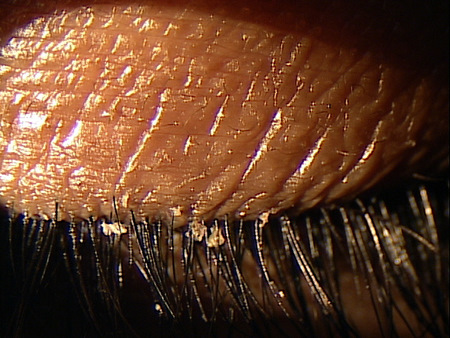ICD-10 Diagnosis Code
B88.0–Other acarasis
Title
Demodex Folliculorum
Category
Inflammation Of Eyelids
Description
Demodex folliculorum is a infestation of mites in the lash line that can cause inflammation of the eye lids and eye.
Demodex mites are intradermal parasites, which thrive in follicles and sebaceous glands of humans and animals. Demodex is spread by direct contact and probably by dust containing eggs. Demodex folliculorum can cause anterior blepharitis associated with disorders of the eyelashes, and demodex brevis can cause posterior blepharitis with meibomian gland dysfunction and keratoconjunctivitis.
The condition is characterized by the following abnormal clinical sign:
- A clear tubular cuff, known as cylindrical dandruff, which is attached to the eyelid margin and encircles the eyelash base
Structural Damage to the Eye
- Anterior blepharitis
- Keratoconjunctitivitis
- Meibomian gland dysfunction
- Blepharoconjunctivitis
- Blepharokeratitis
Functional Damage to the Eye
- Blurry vision
The goal of the diagnostic evaluation in a patient with demodex folliculorum is to:
1. Stage the disease based on its clinical features:
- Patient symptoms
- Eyelash appearance
- Ocular surface staining
2. Relieve ocular pain and discomfort
- Prescribe a treatment program to treat the demodex folliculorum
- Prescribe a treatment program to treat any associated dry eye syndrome and potential blepharitis, keratitis, and conjunctivitis
Patient History
Patients with demodex folliculorum usually present with some or all of the following symptoms:
- None
- Burning sensation of the lids
- Foreign body sensation that originate beneath the lids
- Eyelid itching
- Crusting and redness of the eyelid margin
Ocular Manifestations
- A clear tubular cuff, known as cylindrical dandruff, which is attached to the eyelid margin and encircles the eyelash base
- Intermittent trichiasis
- Meibomian gland dysfunction
- Conjunctival Inflammation
- Corneal and conjunctival vascularization
Demodex folliculitis, meaning inflammation of the follicle due to Demodex mites, can be morphologically divided into the following classifications:
- Papulopustular — Involves the perioral and periorbital areas of the face with agminated follicle-bound lesions in an irregular shape
- Nodulocystic — Includes intense inflammatory reaction including pus and suppurative succulent changes
- Conglobate — Depicts abscess-like lesions
Chalazion
A chalazion, also known as a meibomian gland lipogranuloma, is a cyst in the eyelid that is caused by inflammation of a blocked meibomian gland, usually on the upper eyelid. Chalazia differ from styes (hordeola) in that they are subacute and usually painless nodules. They may become acutely inflamed, but unlike a stye, chalazia usually sit inside the lid rather than on the lid margin.
Hordeolum
A hordeolum is a common disorder of the eyelid. It is an acute focal infection (usually staphylococcal) involving either the glands of Zeis (external hordeola, or styes) or, less frequently, the meibomian glands.
The life span of the demodex is approximately 20 days. If they are not treated properly and aggressively, the mites multiply rapidly. The most effective way to prevent the mites from mating is through hygiene and antiseptic solutions.
The goals of treating demodex folliculorum include the following:
1. Scrubbing the lids with Tea Tree Oil solution causes the embedded mites to migrate out of the skin.
2. Applying a 5% Tea Tree Oil Ointment or a steroid/antibiotic ointment such as Tobradex ointment or Maxitrol ointment to the lids at night. The ointments stop the mites from mating and the Tobradex or the Maxitrol Ointment works effectively in treating the blepharitis component.
3. Ongoing and continual hygiene is necessary to eradicate the condition. This involves using a commercially available cleansing pad called Cliradex. Also, after each treatment the patient’s bedding needs to be cleaned with hot water and replaced. Heat effectively kills demodex. Ultimately, unless both doctor and patient stays on top of therapy, the mites will propogate.
1. Roque M. Demoticosis. Medscape/EMedicine. 1 May 2013. http://emedicine.medscape.com/article/1203895-overview#showall. Last accessed February 25, 2015.
2. Chen W, Plewig G. Human Demodicosis: Revisit and a Proposed Classification. The British Journal of Dermatology. 2014;170(6):1219-1225. http://www.medscape.com/viewarticle/827229_1. Last accessed February 26, 2015.
133.8
Other acariasis
Occurrence
- Increases with age, occurring in approximately 85% of the population at age 60 and 100% of the population older than 70
- Demodex folliculorum is also found in young adults
Distribution
- Equally distributed among males and females
- More prevalent in older adults
- Appears less frequently in people who wear eye makeup




 Print | Share
Print | Share

